While the Arleigh Burke class destroyers are the backbone of the US surface fleet today, the older Ticonderoga class cruisers are still important, particularly in the high-end air and missile defense roles. As such, it's worth taking a look at these ships. The Ticonderoga class is closely associated with Aegis, the US Navy's integrated air defense radar/tracking system, and rightly so. It was the final result of a long and difficult process of figuring out how to take that system to sea, and its arrival revolutionized the world of naval air defense.
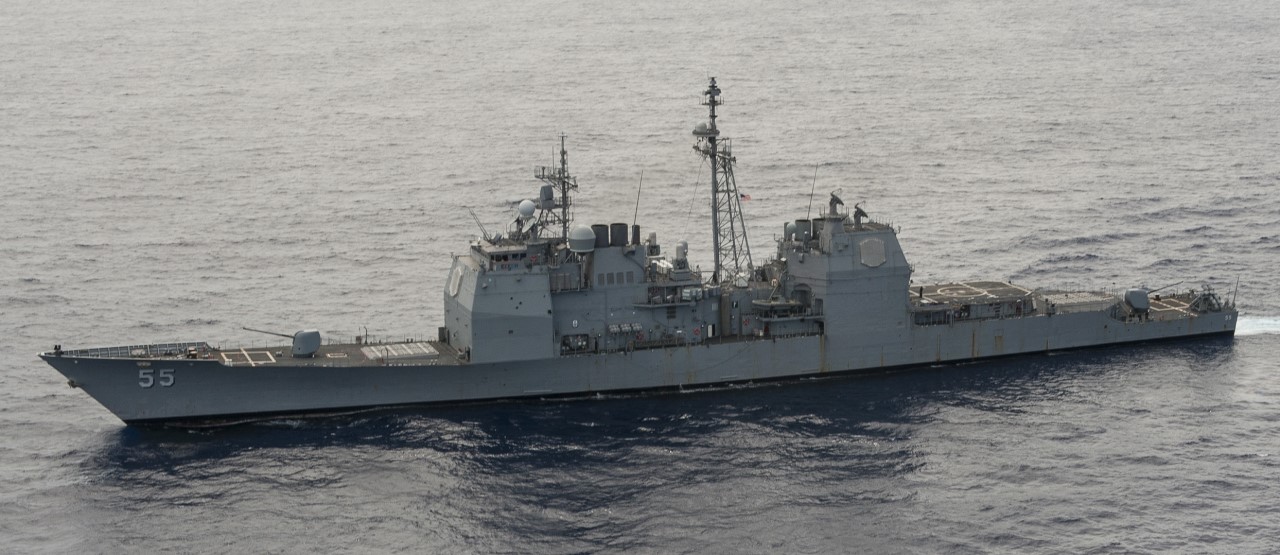
Leyte Gulf of the Ticonderoga class
Aegis development began in 1963, after the cancellation of the previous Typhon system, which was intended to implement a very similar track-while-scan multitarget system, but with analog electronics. It didn't really work, so it was cancelled and development started again on a digital system. By 1969, all of the conceptual problems had been solved, and it was merely a matter of figuring out what sort of ship would carry it. Unfortunately, this is where things went wrong, as two powerful elements within the Navy clashed. On one hand, there was Admiral Hyman Rickover, the head of Naval Reactors, who continued to serve long past the mandatory retirement age at the behest of Congress. His close relationship with many in Congress (often helped by naming ships after them or their towns) had resulted in a legal requirement that all surface warships over 8,000 tons needed either nuclear power or a good explanation why they wouldn't use it, and to him, Aegis was the obvious system to equip the next generation of nuclear-powered cruisers. On the other hand, there was Elmo Zumwalt, who took over as Chief of Naval Operations in 1970 despite being 20 years Rickover's junior. Zumwalt was primarily concerned with the impending collapse in warship numbers as WWII-era vessels were retired en masse, and had a strong focus on keeping unit costs down. He even considered cancelling Aegis, as it didn't fit with his focus on protecting the sea lanes of the Atlantic against submarines.
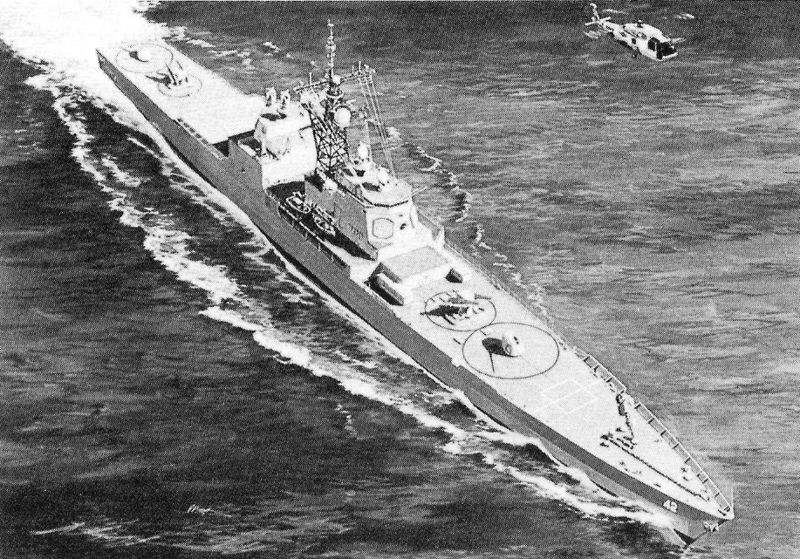
A drawing of one version of the Strike Cruiser
Eventually, Zumwalt was persuaded to let Aegis procurement go ahead, although he demanded it fit on a conventionally-powered ship of only 5,000 tons that could cost no more than $100 million in 1973 dollars. A study quickly showed that any design which could meet this criteria was too austere even for Zumwalt, but even raised limits failed to produce a satisfactory ship. On the nuclear side, Naval Reactors, apparently in a bid to design a new reactor, said that the existing Virginia class missile cruisers couldn't accommodate Aegis, and a new, bigger design would be needed. The impasse lasted until Zumwalt's departure as CNO, when his replacement, James Holloway III1 began backing a nuclear Aegis escort. To justify the extra cost of the nuclear plant, it had to show a significant advantage over a conventional Aegis ship. This was to be found in size, which would allow it to carry other weapon systems and emphasize survivability, largely neglected since the end of WWII. The so-called Strike Cruiser would in theory be able to survive 5 cruise missile hits, while a minimum Aegis ship would be seriously damaged by a single missile. It would also bring more than just anti-aircraft firepower, with Harpoon missiles, Tomahawk ABLs, and even an 8" gun. All of this would take at least 16,000 tons, and the cost began to make Congress wary of the project. Advocates plowed on, with some even suggesting that it should be fitted with a proper flight deck for STOVL aircraft, producing what appeared to be a genuinely all-purpose warship, but at a staggering cost.
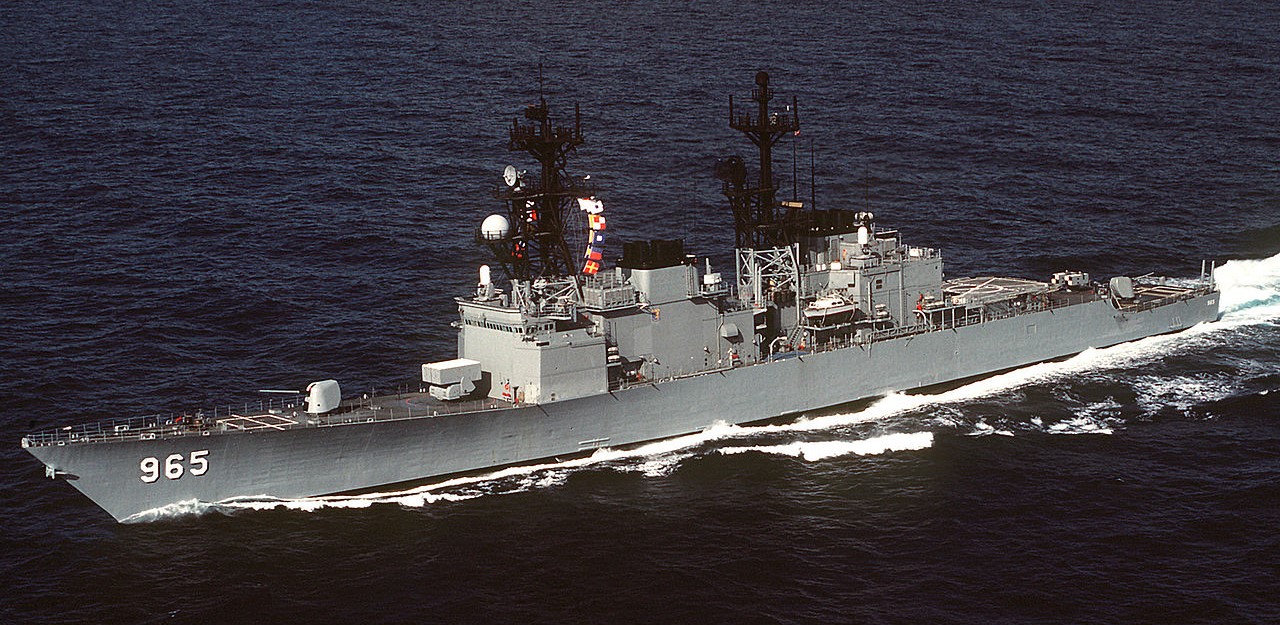
Spruance class destroyer Kinkaid
The alternative to the strike cruiser came from the Aegis program office itself. They had identified the hull of the Spruance class destroyer, currently being procured as an ASW escort, as an ideal platform for the new system. The Spruance had been developed around the idea of a common hull for anti-submarine and anti-air escorts, with lots of growth margin for future systems. Shockingly, this quite good idea came out of the McNamara DOD. In practice, only the anti-submarine version was bought by the US, although the Shah of Iran ordered four AAW ships, which were taken over by the US after the Iranian Revolution as the Kidd class. The massive design margins for not only the DDG conversion but also future systems, which led to the Spruances themselves being criticized as underarmed, allowed the Aegis team to fit the entire system onboard a modified version of the Spruance hull. With the Strike Cruiser growing out of control and Aegis in serious danger of cancellation, the Navy finally got its act together and the Spruance/Aegis combination was finally authorized the FY 78 budget.
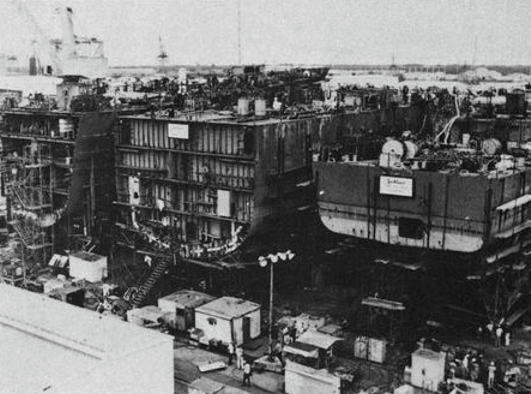
Hull sections of USS Yorktown, second ship of the class, at Ingalls Shipbuilding in Pascagoula, Mississippi
The new ship was initially considered a guided-missile destroyer, and given the next number in the DDG series, DDG-47, and named Ticonderoga in flagrant violation of destroyer naming traditions.2 The type designation was changed to cruiser on January 1st, 1980, three weeks before the ship was laid down, but the hull numbers of the first four ship, already ordered, were retained.3 Detailed design and construction were plagued with difficulties, as Aegis pushed the very limits of the hull's capability, particularly with respect to topweight. Oversights in the design, such as basing practices off the heavier Kidds instead of the base Spruances, were enough to push the ship past the safe displacement and raise the center of gravity past the absolute maximum the hull could cope with. Eventually, ballast and some structural changes solved the problem, but the Ticonderogas had little growth margin, and their performance in heavy seas is charitably described as unpleasant.
Ticonderoga and Iowa underway together in 1987
Ticonderoga was commissioned on January 22nd, 1983, on time and on budget despite the design problems. The four SPY-1 radars were located in two deckhouses, one forward and one aft, each independent for survivability. Fore and aft are Mk 26 twin-arm launchers, each with a 44-missile magazine capable of carrying both Standard MR and ASROC. Four illuminators provide terminal homing for the Standards. Two 5" guns could be used for shore bombardment or surface warfare, and two quad Harpoon launchers gave longer-range anti-ship punch. Two helicopters land on a pad forward of the aft gun and missile launcher, and provide the majority of anti-submarine firepower, although the ships also have an active sonar in the bow, a towed array, and a pair of triple torpedo tubes, which usually carry Mk 46 torpedoes.
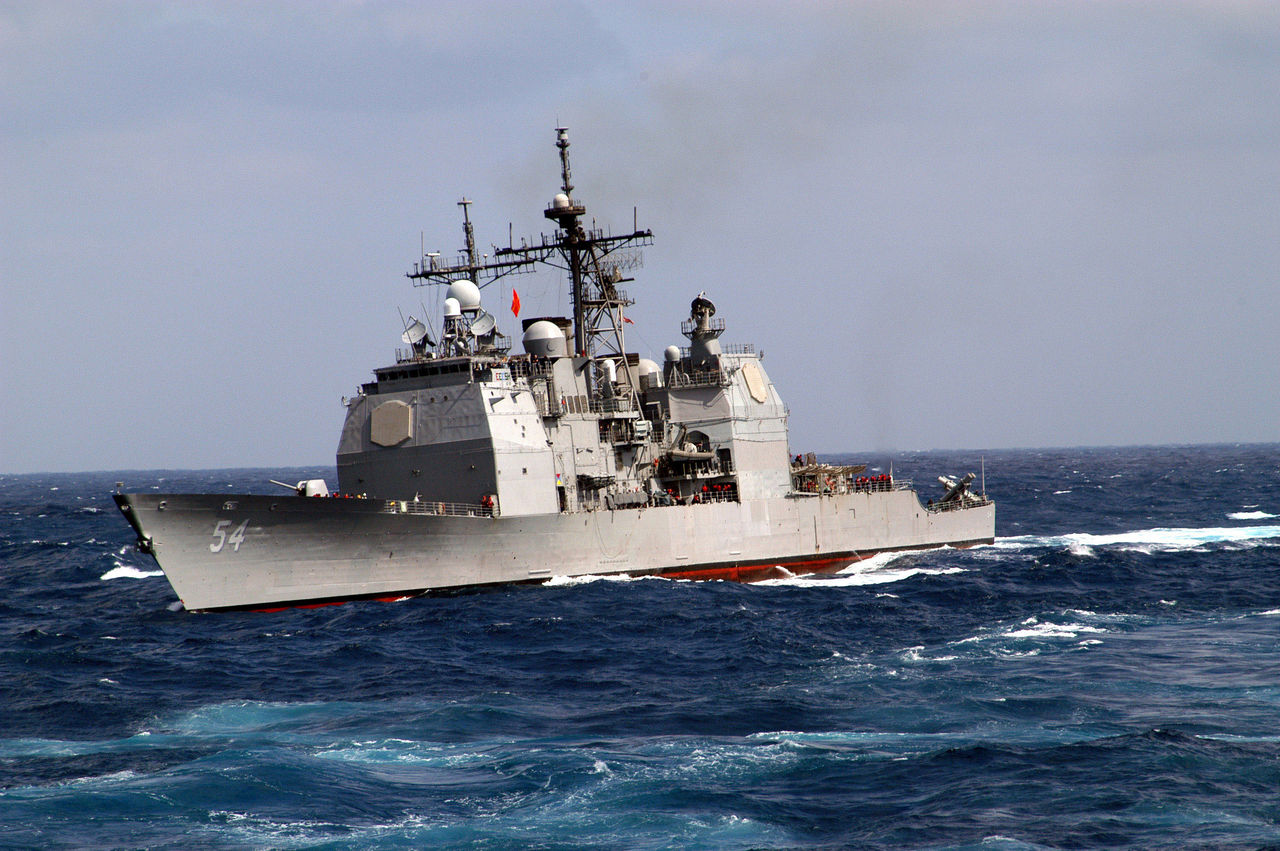
Antietam, an early VLS ship, rolls in rough weather
The first five ships were built to this standard, before the so-called Baseline 2 was introduced. The major improvement on the new ship was the replacement of the Mk 26 with a pair of 61-cell Mk 41 Vertical Launch Systems. These had a number of substantial advantages. The missile capacity rose from 88 to 122, while rate of fire increased and the ships gained the capacity to use Tomahawk cruise missiles.4 Unfortunately, Tomahawks were heavier than Standards, so to let the new ships carry more than about two dozen, topweight would have to be reduced. The designers managed to find more spaces low in the ship, and shuffled components downward, ultimately lowering the rear deckhouse by two feet and coming in 7% under the target weight.
The weapon and sensor fit of a VLS Ticonderoga, 1994
Seven cruisers were built to the Baseline 2 design, followed by 9 Baseline 3s with lighter SPY-1B radars, which had also been modified to give improved antimissile performance. The last 6 ships, for a total of 27, were known as Baseline 4, and differed from Baseline 3 in having faster computers. Ultimately, the 27 Ticonderogas proved vital in enabling Reagan's Maritime Strategy of forward operations against the Soviets, giving the surface fleet a good chance of shooting down anti-ship missiles and freeing the fighters to hunt bombers. The first five ships were retired in the mid-2000s, but the others have soldiered on, often serving as the command ship for a carrier group's escort, a role the Burkes don't have facilities for. Current plans have some units of the class serving until 2040.
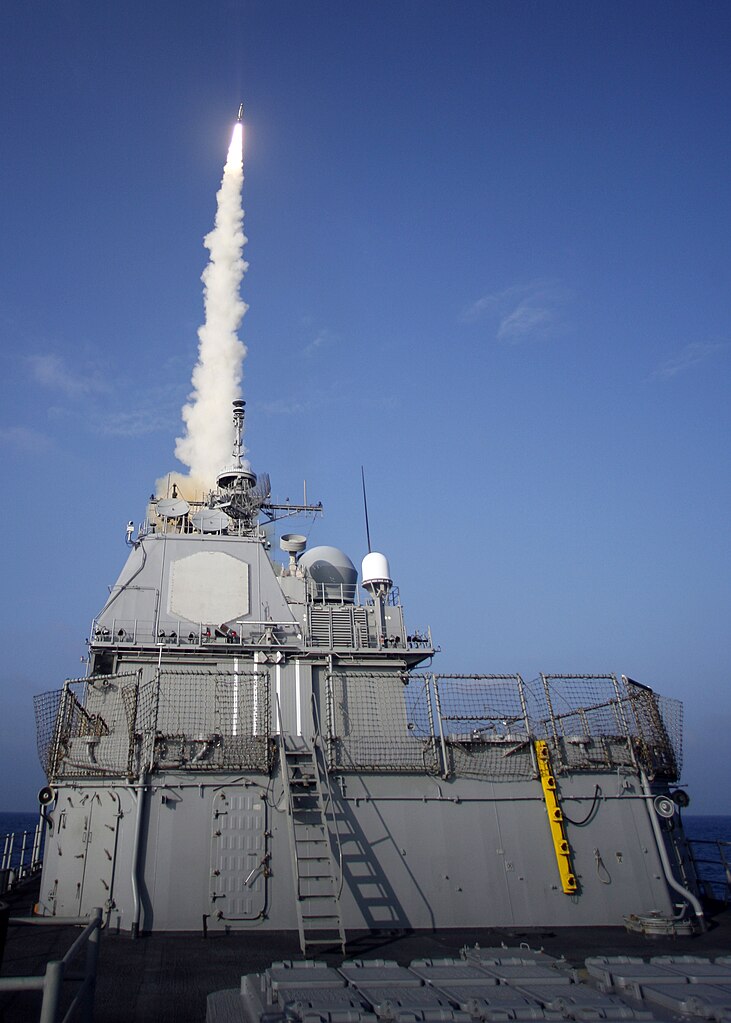
An SM-3 climbs away from Lake Erie, bound for USA-193
In service, the Ticonderogas proved highly effective, giving commanders access to an air picture of unprecedented detail. The system was initially politically controversial, and in 1988, its reputation further suffered when Vincennes shot down an Iranian airliner. During Desert Storm, several of the VLS-equipped ships participated in Tomahawk strikes against Saddam's forces, a practice that has continued in most of Tomahawk's subsequent combat uses. More recently, the cruisers have played an important part in the growth of Aegis into a missile-defense platform. In 2008, Lake Erie became the only ship ever to shoot down a satellite. USA-193 was a reconnaissance satellite that had failed in orbit, and officials were worried that it would injure or kill those on the ground if its hydrazine tank survived reentry. An SM-3 successfully intercepted it, one of dozens of successful tests of the SM-3/Aegis partnership. More recently, it has served in the Red Sea, although its actions there are not exactly distinguished.
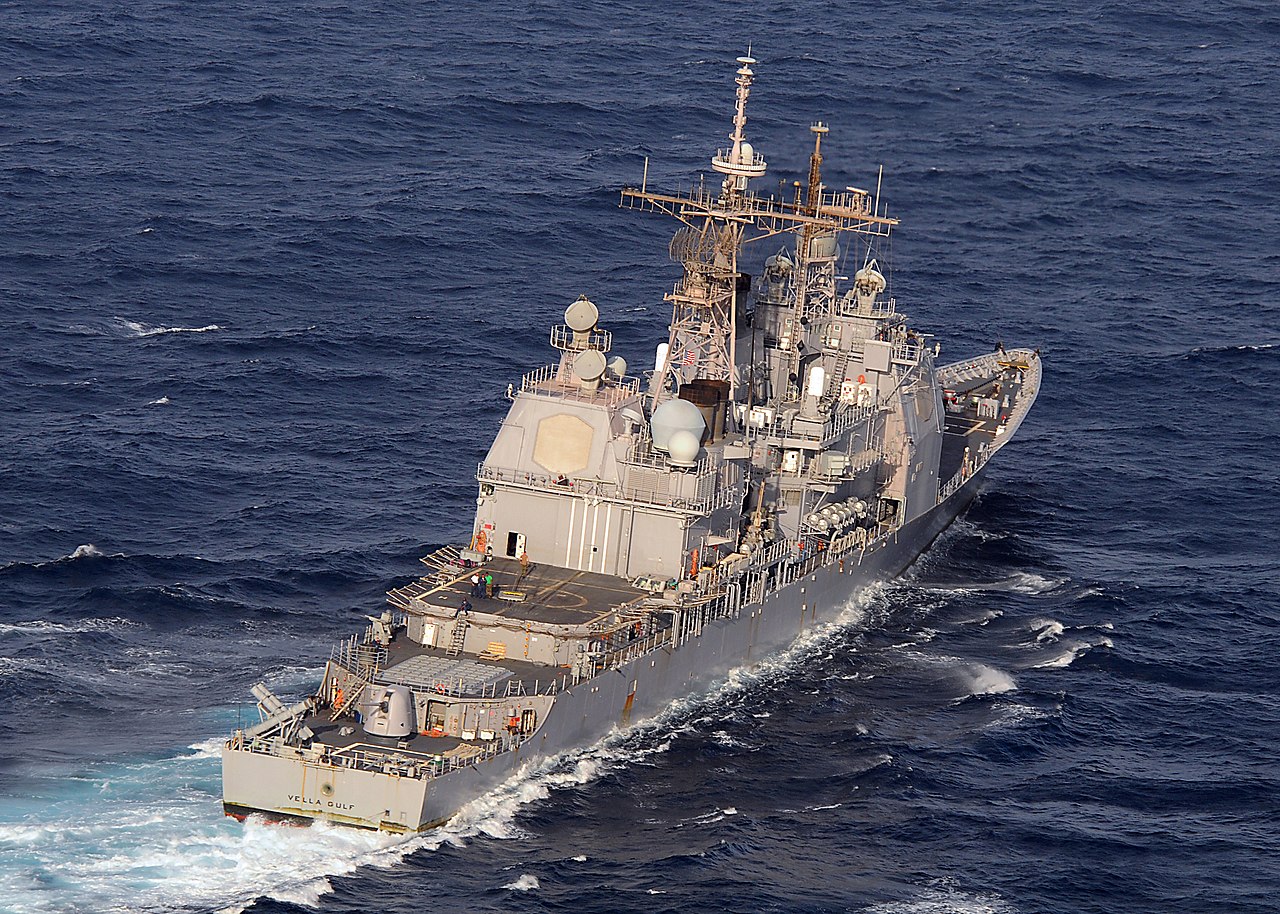
USS Vella Gulf
Today, the Ticonderogas are in the twilight of their careers, and 8 of the VLS ships have been retired, to be replaced by the Flight III Burkes as those enter the fleet. However, those ships still have the limitations of their type, and plans continue to be discussed for a proper cruiser successor. The first attempt, CG(X) would have been based on the Zumwalt hull, but with an Aegis radar, more VLS cells, and even potentially a nuclear reactor. It was cancelled in 2010, and currently early studies are in work on the so-called Large Surface Combatant (LSC)5 with initial procurement currently planned for FY2028, with the ship actually entering service a decade or so later. But until then, the Ticonderogas will have to soldier on.
1 Holloway's father, James Holloway II, had been captain of Iowa. ⇑
2 Yes, my information says this happened before they redesignated the class as CGs, which I hadn't previously realized. ⇑
3 This resulted in gaps in both the cruiser and destroyer series. The previous CG series ran through CG-41, while the destroyer series had gotten to DDG-46. CG-42 through CG-46 are unused, as are DDG-47 through DDG-50. ⇑
4 With all of these benefits, it's hard to see why the first ships didn't use VLS. It's possible that it was a perception issue, as the Spruances in particular had come under heavy criticism for not having sufficient armament, particularly compared to contemporary Soviet warships. VLS definitely looks less impressive than a twin-arm launcher. However, it's more effective, and the Soviet ships often had so many electronics because they had to carry what were essentially hot spares for when the primary systems broke down. Repairs were generally carried out in port. ⇑
5 Can I mention how much I hate this particular acronym, which is going to get confused with LCS all the time? ⇑

Comments
I despair of what naming convention they might use for LSC, what with major-city names being used for ~~heavy corvettes~~Littoral Combat Ships.
A half-baked notion I have says to build a class named after battles-that-are-also-major-cities, like say Lexington (never mind that the Battle of Lexington didn't happen in Lexington, KY, but hey), where they'd be integrating the tried-and-true combat systems of the Burkes with a new hull and nuclear-turboelectric drive or something like that, followed by a new class with the same hull and engine plant but updated combat systems named for state capitols. But that would make sense, so it's vanishingly unlikely.
I would assume they'd probably get the battle names, which are currently unused (the LHD/LHAs are a partial exception, but those are Marine battles these days, and look set to stay that way). The first batch would presumably be a lot of the historic carrier names that we aren't currently using. Lexington, Saratoga, Yorktown, Ranger. But as you say, that makes sense, so it's unlikely.
Failing that, I vote we name the class after Louis Denfeld. Actually, never mind. He should get the next CVN.
Famously also called the Ayatollah or Dead Admiral-class
@Jade: by this point, we'll probably just give up all pretenses and start naming them after whichever random Congresscritters who were on subcommittees that authorized their construction.
by this point, we’ll probably just give up all pretenses and start naming them after whichever random Congresscritters who were on subcommittees that authorized their construction.
That might be the best option, because otherwise who knows what kind of insane naming convention modern politics might throw up (in the sense of vomit). Hufflepuff class anyone?
Like the Hindenburg. Named for popular German politician and general Hindenburg, because there was enough political support for that name to resist the growing pressure to name it the Adolph Hitler, which the Zeppelin company DID NOT WANT.
I wonder if that contributed to Hitler's paranoia about ship naming during the war. He was worried about the political effects of the loss of a ship with a significant name, and it seems like he dodged a bullet with that one.
I never bought that and I don't think China (who that shootdown was actually aimed at) did either.
Besides, why haven't the US done it again?
First of all, I don't think the US Navy would use names from a British novel series. Secondly, is it bad that I kind of want to see the RN have a Hufflepuff class? I'm thinking they could be something like oilers or some other kind of auxiliary. Just quietly chugging away in the background, keeping the more famous ships fighting fit and ready to go.
Presumably they'd also get a Slytherin class of attack submarines. After that, I'm thinking Gryffindor class destroyers and Ravenclaw class frigates.
I wonder if this would help with recruitment and retention?
I've heard that the Japanese have started naming their submarines after anime dragons with the Soryu class. Obviously, these are not names new to Japanese warships, but they were apparently selected with an eye towards appealing to the youths, and it may have even worked. I may check with the local anime fan to see if she recognizes the names as anime things.
I would have guessed that if there is a Hufflepuff class, then the ships in that class would be following the same naming theme, with HMS Hufflepuff, HMS Slytherin, HMS Gryffindor, Ravenclaw, Hogwarts, Boggart, Voldemort...
Then, the next class could follow a different, but related, theme, with HMS Frodo, HMS Bilbo, HMS Pippin ...
Meanwhile JDS Godzilla
I would also assume that a Hufflepuff class would either be followed by other Potter-themed names, or have ships named after Hufflepuffs.
Re Japan, I checked with the resident anime expert, and none of the first batch of names sounded familiar to her. Our joint guess is that the naming theme was swapped from ocean currents to dragons because they sounded cooler, but not because of any specific ties to anime.
I thought the new totally-not ominous Japanese naming scheme was "ships that attacked pearl harbor"
Given RN naming conventions, I'd assume the latter. Like the Town and County class cruisers, or the Flower class corvettes.
Severus Snape silently sent seven Spearfish against Sovremennies sortieing from Shanghai.
Great piece, Bean.
Can you say anything about the relative capacities of the Ticos and Burkes? I know the cruiser/destroyer nomenclature is pretty arbitrary at this point, and at least in tonnage they're pretty close...Burkes are presumably somewhat more modernized, but I don't know how much effect this has?
In terms of equipment fit, the big differences are that the Ticos have an extra pair of large displays (which is why they usually are the command ship for AAW) and an extra illuminator (maybe a bit important for saturation attacks, but not a major thing most of the time). Also, some extra VLS cells, and, because it's the lead AAW ship, more SAMs in its VLS. All else equal, the Tico has a slight edge, but the big difference is probably what Aegis version the ship is running, which is going to vary from ship pair to ship pair.
I'm not 100% sure how much different the Aegis variations are between the two classes, but when I was in at least, all the old fixed-function hardware and 16-bit computers were in the process of being replaced with newer, shinier stuff, and the same new, shiny stuff on both classes.
The big differences are mostly that the Ticos have all of a towed sonar, helicopters and Harpoons. On Burkes, Flight I/II have the tail and the Harpoons, while Flight IIa/III have helos. With SM-6 and soon LRASM, the Harpoons won't matter much, though.
That said, AFAIK, cruiser crews don't train as heavily for ASW as DD crews do. (Well, Burke crews - Zumwalts don't have much in the way of ASW gear.) Which makes sense - the CGs are mostly worrying about the air battle and to a lesser extent, surface. ASW screening and hunting is usually somebody else's problem. If I had to guess, the Ticos only have as good an ASW fit as they do because the Spruances already had it, so the integration cost peanuts.
With top weight so much of an issue, would it have been sensible to compromise on radar redundancy? They're so high in the ship that every ton saved must have a huge multiplier.
Don't know. They did it for the Burke, but that was deliberately a trimmed-down design, and I'd guess that the Tico experience gave them more confidence in the reliability of the system.